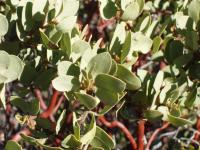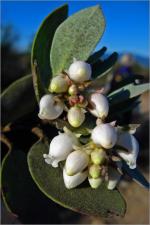Coniferous Forest
Coniferous forests are relatively common throughout the County, occurring on almost 38,000 acres, or 7.5% of the County, concentrated in the Western Mountains, Eastern Mountains, Livermore Ranch, and Angwin areas. Coniferous forests include:
- Redwood forests
- Pine and Fir forests
- Cypress woodland
Redwood forests are highly valued by the public because of the unique structure and feeling of these ancient, giant conifers. Ponderosa pine forests are considered sensitive communities because they are rare within the County, covering less than 200 acres.
Dominant plants found in coniferous forests typically include tanoaks (Lithocarpus densiflora), big-leaf maple, madrone, or California bay. Shrubs associates include California hazel (Corylus cornuta var. californica), oceanspray, and poison oak. The herbaceous understory includes manroot (Marah fabaceus), wakerobin (Trillium spp.), and wood fern (Dryopterus arguta). Pine forests in the County include about 6,000 acres of knobcone pine, which is generally associated with chaparral species such as Eastwood Manzanita (Arctostaphylos glandulosa) and backbrush.

Eastwood manzanita
Arctostaphylos glandulosa

Hoary manzanita
Arctostaphylus canescens

White-flowered musk brush
Ceanothus jepsonii var. albiflorus
Wildlife communities commonly associated with redwood and pine forests include reptiles such as ring-necked snake (Diadophis punctatus) and rubber boa (Charina bottae). Birds include the hairy woodpecker (Picoides villosus), Stellar’s jay (Cyanocitta stelleri), and red-breasted nuthatch (Sitta canadensis). Some mammals include the Trowbridge’s shrew (Sorex trowbridgii), black bear, and gray squirrel (Sciurus griseus).
Common wildlife associated with cypress forests are similar to those associated with oak woodlands. Reptiles include the western skink (Eurneses skiltonianus) and northern alligator lizard (Elgaria coerula). Ensatina (Ensatina eschscholtzii) and the California slender salamander are some examples of amphibians. Birds include the Nuttall’s woodpecker (Picoides nuttalli) and the warbling vireo (Vireo gilvus). Typical mammal species found in the habitat include those described for chaparral communities and include the desert cottontail (Sylvilagus bachmanii) and the Sonoma chipmunk (Tamias sonomae).
Reptiles and Amphibians

Rubber boa
Charina bottae

Ring-necked snake
Diadophis punctatus
Birds

Hairy woodpecker
Picoides villosus

Steller’s jay
Cyanocitta stelleri

Pileated woodpecker
Dendropus pileatus
Mammals

Black bear
Ursus americanus americanus

Western gray squirrel
Sciurus griseus
The primary ecosystem functions and services of coniferous forest in the County are:
-
Maintain water quality through soil retention and by filtering out sediment and nutrients from run-off
-
Maintain stream flows into summer by promoting groundwater recharge and storing water
-
Prevent flooding and minimize channel erosion by slowing surface run-off
-
Provide wildlife habitat
-
Provide carbon assimilation and sequestration to slow climate change
-
Provide forest products including lumber and firewood
-
Provide opportunities for recreation including, but not limited to, hunting, bird-watching, hiking, horseback riding, off-road vehicle use
Use the map below to explore the various biotic communities throughout Napa County.


